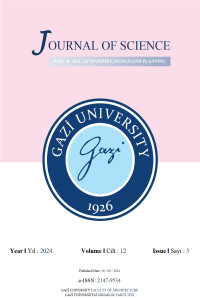Abstract
The design of biophilic spaces that are directly or indirectly integrated with nature is an important requirement in social spaces that affect the mental and physical health of users, such as libraries. Built in 2018 in Helsinki, Oodi Central Library is a building that attracts attention with its biophilic design features. In the study, the evaluation of the building is based on three different approaches developed by Kellert and Calabrese in 2015; direct experience of nature, indirect experience of nature and experience of place and space. The components of the building such as light, air, plants and materials were analyzed within the scope of biophilic criteria and the findings of the analysis were transferred to a table. The biophilic design of the library increases the interaction of users with nature. While this study emphasizes the importance of biophilic design for library buildings, it also serves as a resource to show how biophilic criteria can be used effectively for future designs. In this way, it demonstrates the potential of biophilic design in architecture and interior design and increases the body of knowledge in this field. Ultimately, the study contributes to enriching users' quality of life and learning outcomes by advocating for the wider adoption of biophilic design in public spaces.
References
- [1] URL-1: U.S. Environmental Protection Agency. 2003. EPA assessment of risks from radon in homes. EPA/402/R-03/003. Washington, DC. https://www.epa.gov/sites/default/files/2015-05/documents/402-r-03-003.pdf, Accessed: 26.07.2024
- [2] URL-2: https://www.epa.gov/report-environment/indoor-air-quality#note1, Accessed: 26.07.2024
- [3] Kellert, S. R. (2012). Building for life: Designing and understanding the human-nature connection. Island press.
- [4] Leather, P., Pyrgas, M., Beale, D. and Lawrence, C. (1998), “Windows in the workplace: sunlight, view, and occupational stress”, Environment and Behavior, Vol. 30, pp. 739-762, doi: 10.1177/ 001391659803000601.
- [5] Yanni, C. (2003), “The linear plan for insane asylums in the United States before 1866”, Journal of the Society of Architectural Historians, Vol. 62, pp. 24-49.
- [6] Louv, R. (2008), “Last child in the woods: saving our children from nature-deficit disorder, Updated and expanded”, Algonquin Books of Chapel Hill, Chapel Hill, NC.
- [7] Ramzy, N.S. (2015), “Sustainable spaces with psychological connotation: historical architecture as reference book for biomimetic models with biophilic qualities”, ArchNet-IJAR, Vol. 9 No. 2, p. 20.
- [8] Gillis, K., & Gatersleben, B. (2015). A review of psychological literature on the health and wellbeing benefits of biophilic design. Buildings, 5(3), 948-963.
- [9] Ohly, H., White, M.P., Wheeler, B.W., Bethel, A., Ukoumunne, O.C., Nikolaou, V. and Garside, R. (2016), “Attention Restoration Theory: a systematic review of the attention restoration potential of exposure to natural environments”, Journal of Toxicology and Environmental Health, Part B, Vol. 19, pp. 305-343, doi: 10.1080/10937404.2016.1196155.
- [10] Chang, C., Cheng, G., Nghiem, T., Song, X., Oh, R., Richards, D. and Carrasco, L. (2020), “Social media, nature, and life satisfaction: global evidence of the biophilia hypothesis”, Scientific Reports, Vol. 10 No. 1, p. 4125, doi: 10.1038/s41598-020-60902-w.
Abstract
References
- [1] URL-1: U.S. Environmental Protection Agency. 2003. EPA assessment of risks from radon in homes. EPA/402/R-03/003. Washington, DC. https://www.epa.gov/sites/default/files/2015-05/documents/402-r-03-003.pdf, Accessed: 26.07.2024
- [2] URL-2: https://www.epa.gov/report-environment/indoor-air-quality#note1, Accessed: 26.07.2024
- [3] Kellert, S. R. (2012). Building for life: Designing and understanding the human-nature connection. Island press.
- [4] Leather, P., Pyrgas, M., Beale, D. and Lawrence, C. (1998), “Windows in the workplace: sunlight, view, and occupational stress”, Environment and Behavior, Vol. 30, pp. 739-762, doi: 10.1177/ 001391659803000601.
- [5] Yanni, C. (2003), “The linear plan for insane asylums in the United States before 1866”, Journal of the Society of Architectural Historians, Vol. 62, pp. 24-49.
- [6] Louv, R. (2008), “Last child in the woods: saving our children from nature-deficit disorder, Updated and expanded”, Algonquin Books of Chapel Hill, Chapel Hill, NC.
- [7] Ramzy, N.S. (2015), “Sustainable spaces with psychological connotation: historical architecture as reference book for biomimetic models with biophilic qualities”, ArchNet-IJAR, Vol. 9 No. 2, p. 20.
- [8] Gillis, K., & Gatersleben, B. (2015). A review of psychological literature on the health and wellbeing benefits of biophilic design. Buildings, 5(3), 948-963.
- [9] Ohly, H., White, M.P., Wheeler, B.W., Bethel, A., Ukoumunne, O.C., Nikolaou, V. and Garside, R. (2016), “Attention Restoration Theory: a systematic review of the attention restoration potential of exposure to natural environments”, Journal of Toxicology and Environmental Health, Part B, Vol. 19, pp. 305-343, doi: 10.1080/10937404.2016.1196155.
- [10] Chang, C., Cheng, G., Nghiem, T., Song, X., Oh, R., Richards, D. and Carrasco, L. (2020), “Social media, nature, and life satisfaction: global evidence of the biophilia hypothesis”, Scientific Reports, Vol. 10 No. 1, p. 4125, doi: 10.1038/s41598-020-60902-w.
Details
| Primary Language | English |
|---|---|
| Subjects | Architectural Design, Architecture (Other) |
| Journal Section | Architecture |
| Authors | |
| Publication Date | September 30, 2024 |
| Submission Date | July 26, 2024 |
| Acceptance Date | September 30, 2024 |
| Published in Issue | Year 2024 Volume: 12 Issue: 3 |

